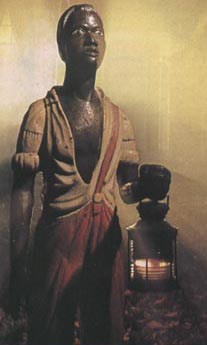An owner tells us what it REALLY means
 September 22, 2017 ~ For a long time, lawn jockeys have adorned the front yards of American homes, but you may have noticed in recent decades that the number of them is fewer and fewer. Somewhere along the line, they started being touted as a symbol of racism. One woman says that she grew tired of people trying to ‘educate’ her about her lawn jockey, and of complaints that she needs to take it down. With a single social media post, the woman blew away her critics.
September 22, 2017 ~ For a long time, lawn jockeys have adorned the front yards of American homes, but you may have noticed in recent decades that the number of them is fewer and fewer. Somewhere along the line, they started being touted as a symbol of racism. One woman says that she grew tired of people trying to ‘educate’ her about her lawn jockey, and of complaints that she needs to take it down. With a single social media post, the woman blew away her critics.
Sandra Dee McNair (header image) owns a lawn jockey and proudly displays it in front of her home. The figures of a black footman in a jockey uniform holding up a lantern have become a controversial figure in recent years, and in this time when racial sensitivities are high, a lot of people have not been able to hold back from chastising McNair about her choice of lawn art.
McNair took to Facebook to explain it once and for all with a mic-drop post. “I often get asked about my lantern footman sitting in my front yard,” McNair begins, telling her that black people have told her that ‘it makes people think you are a racist’ or ‘it is offensive to white people’. McNair says she just laughs off the ignorance.
“I’m really amazed at how a lot of people don’t know the real meaning behind these statues, so they vandalize them, bitch about them being racist, etc.,” she goes on. “The image of a black ‘footman’ with a lantern signified the home was a stop on the Underground Railroad. These are largely a northern thing, and weren’t commonly found in the South until after WWII when northerners moved there and brought this custom with them.”
The Underground Railroad used a lot of symbols to help guide slaves to freedom, and modern historians have been busy trying to decode some symbols believed to be significant. Historians have found patchwork quilts that they believe were actually maps to help slaves learn the way. Code words were used by people working on the Underground Railroad to communicate with others in the know. Tying a green ribbon on a lawn ornament meant an Underground Railroad supporter lived in a home.
“The clothing of the statue was also coded. A striped jockey’s shirt meant that this was a place to swap horses, while a footman in a tailed coat meant overnight lodgings/food, and a blue sailor’s waistcoat meant the homeowner could take you to a port and get you on a ship to Canada,” wrote McNair.
Other sources commonly report that a green scarf tied around a jockey’s neck reportedly meant runaway slaves were welcome to come in, while a red scarf meant that the house was under surveillance and they should keep away.
Lawn jockeys were named after Jocko Graves, an African-American hero. As a youth, Graves served under General George Washington as he crossed the Delaware. Washington left Graves to take care of horses and keep a light on at night to help Washington’s troops return to the Pennsylvania shore. When Washington and his troops returned, they found the dedicated Graves had frozen to death, lantern still in hand, on the river bank. Even dying, the young man refused to abandon his post. Washington was so moved by Graves’ dedication that he commissioned a statue of him and installed it on the lawn at his Mount Vernon estate. The statue was originally entitled ‘The Faithful Groomsman’.

Jocko Graves
“I always laugh when I hear black folks talk about how racist these are, because honestly, the cats who had them were likely the LEAST racist. Later, these came back into popularity after WWII, and they were again coded to show the white homeowners supported early civil rights efforts, weren’t Klan, etc.” McNair, who herself is African-American, concludes in her post.
Written by Mackenzie Wright and published by the Independent Journal Review ~ September 22, 2017.
FAIR USE NOTICE: This site contains copyrighted material the use of which has not always been specifically authorized by the copyright owner. We are making such material available in our efforts to advance understanding of environmental, political, human rights, economic, democracy, scientific, and social justice issues, etc. We believe this constitutes a ‘fair use’ of any such copyrighted material as provided for in section 107 of the US Copyright Law. In accordance with Title 17 U. S. C. Section 107, the material on this site is distributed without profit to those who have expressed a prior interest in receiving the included information for research and educational purposes. For more information go to: http://www.law.cornell.edu/uscode/17/107.shtml
